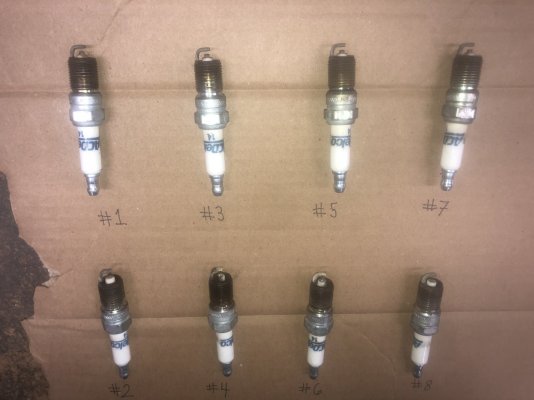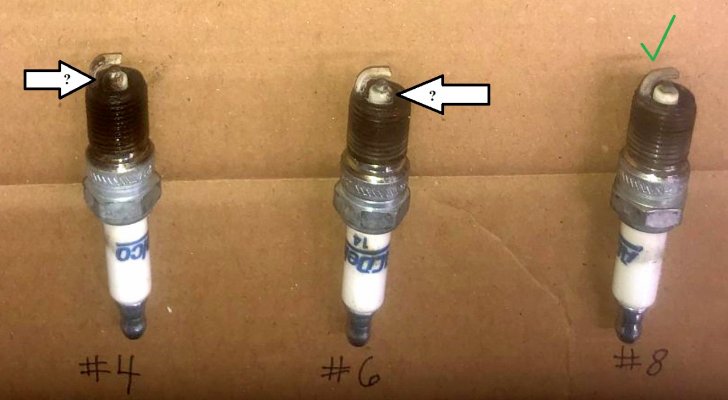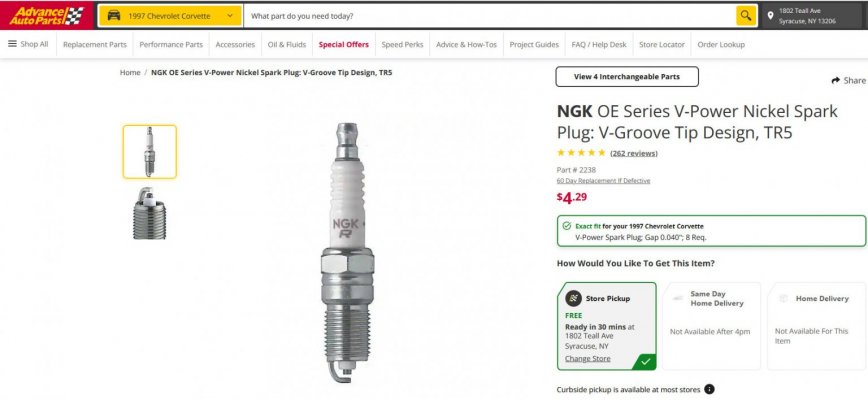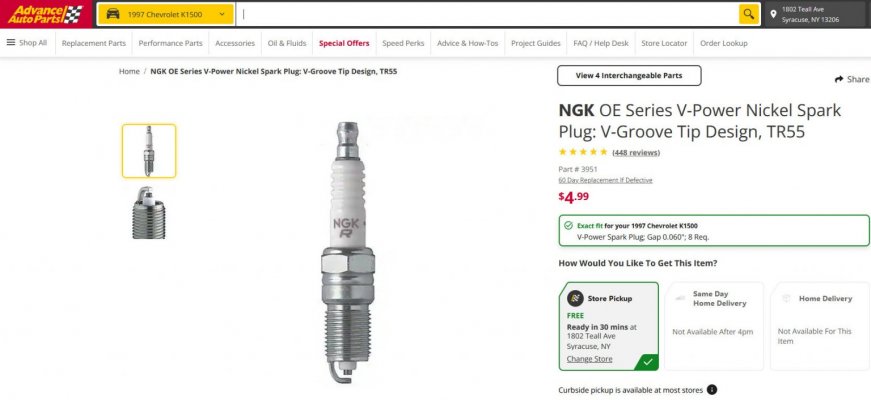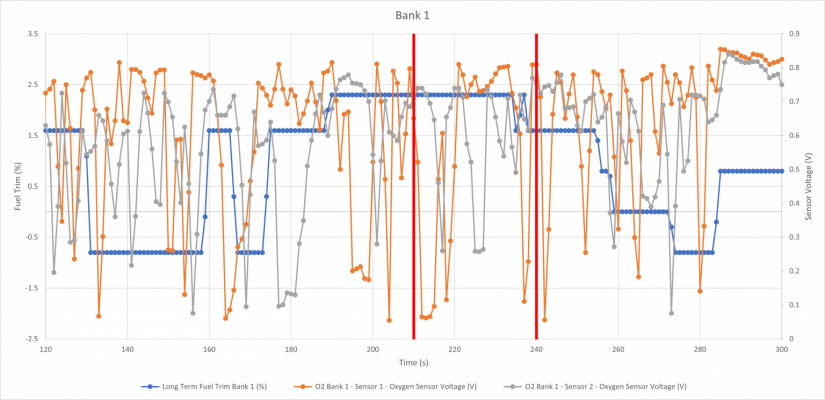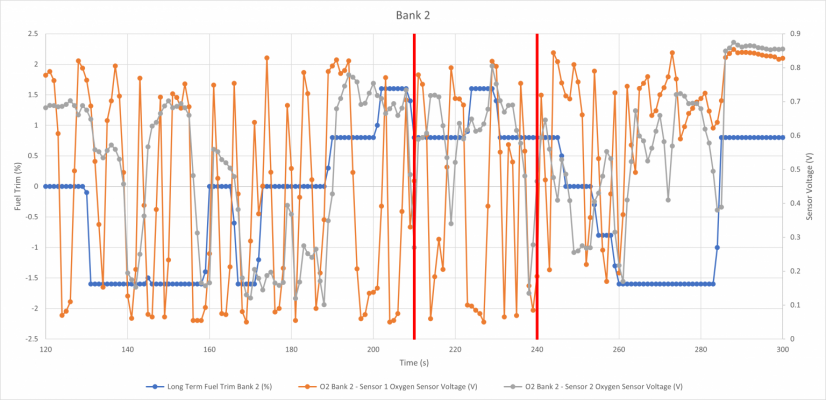More on justifying the .045" recommendation in a bit.
Normally it seems prudent to not discuss politics, which is the best oil, religion, or spark
plug brands & gaps. Seems like Belief System stuff is the 3rd rail of most forums. :0)
But since we're going to methodically troubleshoot this misfire, I gotta go there.
So as to write a chapter instead of a book, here's the bulleted version of
what I found in the Vortec spark plug gap rabbit hole:
* '88-'95 TBI V8s left the factory with spark plugs featuring a .035" gap.
A lot of them still run around just fine on .035" gaps.
* The '96+ Vortecs left the factory with plugs gapped to .060".
Jumping this larger gap necessitates much higher KV (KiloVolts) to do so, and
the higher the psi in the combustion chamber the more KV it takes to reliably
jump the gap. This puts additional stress on the *entire* high voltage
generation/distribution circuit. (Coil > Rotor > Cap > Wires.) And as evidenced
by what we are all reading in this forum, lots & lots of tough to troubleshoot intermittents
stem from this aggressive gap spec.
* Back in '03, GM released a TSB that changed the recommended gap from
.060" to .045". (TSB 03-06-04-060, dated 04-Jun-2003) Note: This took
some digging. Interestingly, this TSB was aimed primarily at the LS motors?
* If you look up your '97 K1500, you will be shown the NGK TR55. Pre-gapped to: .
059"
*
The plug that was released for the TSB above is the NGK TR5. Pre-gapped to: .039"
Note: According to the NGK website, all other parameters besides the gap are the same.
And NGK says that either plug can be safely gapped +/- .010" from as-manufactured.
* I read with interest about a dyno tuner who would open up spark plug gaps in the
hunt for mo' power until he encountered heavy throttle misfires, and then close
them down .010-.015". And he ended up in the .045" neighborhood. (!) His
commentary was intelligent, and I liked the fact that he let the engine tell him what
was working best instead of just going with some spec. (He was wanting to open
up the gaps as much as possible without making the engine fussy or finicky.)
* To see what the heavy hitters in the Vortec world were doing to maximize their toys,
I read a few offshore/marine/boating and a couple of RV sites where the motorhomes are
based on the P30 chassis. (Normally 7.4 or 8.1) I found several anecdotal stories, and
this one is typical of what I read:
You must be registered for see images attach
* NOTE: In the FSM it's documented that the SES light won't illuminate until the issue raises the emissions by an additional
50% over the original emissions specification. (This is the EPA rule that all manufacturers coded to.) So when I read of someone
experiencing misfires that they can feel but the light doesn't come on, I believe them. Shoot, when the chore truck first
followed me home I went from SES constantly on, to SES intemittently on, to SES off but I could still feel intermittent misfiring,
to finally no light & no misfire. (Took 4 passes to sort it all out.)
* The 8.1 story above references AC-Delco plugs. In the dozens of screens that flew by, I thought I saw that back in the '09
timeframe that Delco-Remy sold off the actual spark plug production to NGK? I don't know what changes if any have occurred
since then, but what I do know is that I've used all manner of V-groove NGKs since the '90s and have been very satisfied with them.
(And I'm pretty fussy about this stuff. :0) So I don't know if AC-Delco plugs come out of the same plant as the NGKs or not?
* Before I forget, there was an interesting saga in a boating forum about a freshly rebuilt Vortec 350 (Mercury marine?)
where it would run a steady 4000 rpm full throttle for ~20 minutes, and then suddenly bad sounds would happen, the power would
fall off, and and then after waiting a couple of minutes, the owner would throttle up, and the engine would start running full throttle
normally again for a bit, but fail again after an ever decreasing amount of time for the 2nd, 3rd, and subsequent failures?
After trying many things, the problem was troubleshoot to the Ignition Coil heating up after being run for many minutes
at full power, and then shorting out through the side of the case? And the arcing to ground was the cause of the sound?
(This particular boat owner was tenacious, for in most of the threads like this the boat owners with similar issues (and after
sinking boatloads of money into the troubleshooting :0) ...would just give up and sell their toys for a loss.
* Last & least. For the past year my '99 454 C2500 has been running cheerfully on a set of plugs gapped to .045",
replacing a set to worn plugs that measured in the ~.064" range, plus or minus a handful. Pleased as punch with
the results.
****
Where do we go from here?
* Install a fresh set of NGK TR5 plugs. Ensure that the spark plug wires are dressed just like the
Factory Service Manual has it drawn out. Or cheat and look at
@L31MaxExpress's dressed wiring
harness photos & emulate.
* And even if there's no P1345 code, reverify that your CMP<>CKP synchronization is in spec. We
don't want to risk crossfiring inside the cap to the wrong spark plug terminal because the rotor tip/terminal
physical phasing is off.
I'm sure I could scrape up some more trivia and load it in here, but this feels
like a good place to stop for now.
Q: And why am I being so fastidious about all this?
A: Because if we have Solid fuel delivery + a Robust, blowout-resistant spark,
IF it still goofs up then we will have to start looking at the remaining
member of the triad: Dynamic Mechanical Compression.
If you have any questions about the above, please don't hesitate to ask.
Cheers --
PS - I attached a couple of Advance Auto screens. Try as I might, it
wouldn't let me request a TR5 plug for a '97 K1500...but did come
back with a .060" gap Ruthenium job for ~$14 each? Hey, the tuna is
fine, I don't want the lobster, but thanks for offering. :0)


